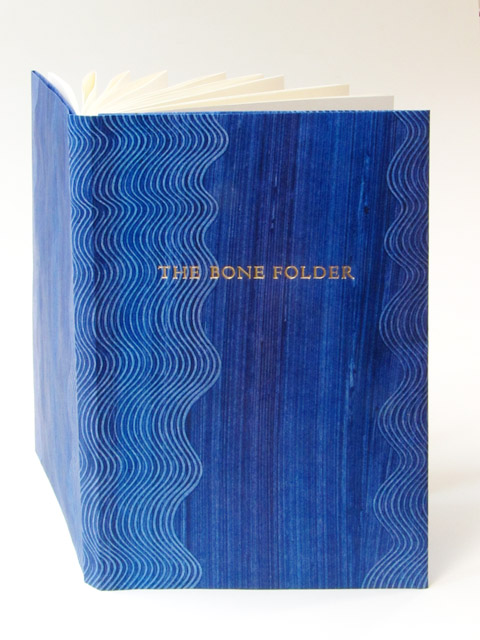The Bonefolder's annual online exhibition.
Artistically Reversible: Where Conservation and Art Meet
We are pleased to present Artistically Reversible: Where Conservation and Art Meet, the 2011 Bonefolder Bind-O-Rama. This online exhibited was inspired by the tenets of the Tomorrow’s Past (TP) movement that seeks to provide antiquarian books with new, conservationally sound yet innovative bindings. The UK-based movement has its roots 1999 with Sün Evrard and was in part inspired by the late Edgar Mansfield who wrote that “surely it is better to create tomorrow’s past than to repeat today’s.” As British binder Jen Lindsay wrote in 2007, “Why go on making books based on Then – copying outdated methods and conventions, instead of making books based on Now – applying current knowledge and practice with a modern sensibility.”TP member Kathy Abbott, a binder and conservator acknowledges that the work of TP has created quite a bit of controversy: some book conservators think we are imposing our will onto the books and think we should be more invisible; book restorers think that we should be making bindings which imitate the period of which the book was printed and book artists seem to like our structures but see us as a bit ‘staid’. This Bind-O-Rama created similar controversy in the US perhaps due to a misunderstanding of both the outcomes and on a deeper level of conservation ethics which as expressed consider every book to be rebound or treated as a cultural heritage artifact. This latter conflict was discussed at length in Barbara Appelbaum’s paper that was presented at the 2011 American Institute of Conservation meeting and entitled Conservation in the 21th Century; Will a 20th Century Code of Ethics Suffice? <http://barbaraappelbaumbooks.com/wp-content/uploads/paper_aic_conservation.pdf>.
While many books are most certainly cultural heritage artifacts either as objects themselves or as part of the collection that holds them, many, the majority perhaps are use objects that have seen a great deal of handling and exhibit their age and provenance through the wear that is exhibited by their deterioration of materials and structure. It is these objects that TP seeks to give new life and a renewed significance whether for collectors or antiquarians. Conservation principles of doing no harm, reversibility (or as expressed by James Reid-Cunningham, conservator at the Boston Athenaeum retreatability) expressed by the use of proven materials with long-term stability, sound structure, and a skillful and respectful expression of craft married to innovation in structure and design. It is the latter which seems to touch the most sensitive nerve with concerns about “appropriateness.” Conservator Chela Metzger writes, “most conservation treatment discusses “appropriateness” or even used the word sympathy when describing a treatment goal. The original old part must meet and mingle with a “non original” new part. The meeting and the mingling must work well at every level. But this appropriateness and sympathy are hard to sum up. Appropriate to the text subject matter? Appropriate for the text paper qualities? Appropriate to the text time period? Appropriate for the owner of the text at the time of the binding?”
As Abbott says, “why can’t we make really, sound, conservation bindings, with a bit of structural ingenuity and a sensitive aesthetic too?” This theme was also echoed in a side-discussion at the Guild of Book Workers 2011 Standards of Excellence Seminar. That discussion featured several conservators and binders working in the US, both with cultural heritage collections and as binders in general. <http://bonefolderextras.blogspot.com/2011/10/discussion-of-tomorrows-past-at-guild.html>.
While the response to this Bind-O-Rama was lower than we hoped, we were very pleased to see conservators and binders take up the challenge. In reviewing the entries we asked “what treatments would disqualify entries from this exhibit? Ones that immediately strike one as hurtful to the text. Ones that do not use stable materials? Ones that require damaging the text to remove it from the new binding. Fortunately we found no evidence that disqualified entries, however we do encourage those interested to see that it is not about traditional “design bindings” or “restoration” but sympathetically innovative conservationally sound bindings.
We hope that binders and conservators will adhere to the highest standards of conservation materials and structure while keeping an open mind and willingness to consider the aesthetic and structural options for rebinding. A large part of that will be an ongoing civil dialog in which conservators continue to stress and share their best practices and we all pragmatically consider the options for rebinding a given book in full consideration of its value and historic significance whatever that may (or may not) be. Writes Abbott, “I do hope that in the future, books bound in this way will be as accepted as every other binding style,” and “I think it could become the most exciting and challenging concept that has come out of the world of bookbinding for a long time.”
Comments by Kathy Abbott of Tomorrow's Past and The Bonefolder editorial staff.
For more information on Tomorrow’s Past see <http://www.outofbinding.com/tp.htm>, Volume 7 of The Bonefolder at <http://www.philobiblon.com/bonefolder/vol7contents.htm>, and Bonefolder Extras at <http://bonefolderextras.blogspot.com/search/label/Tomorrow%27s%20Past>.
ViewArtistically Reversible: Where Conservation and Art Meet


